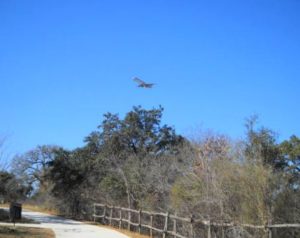John Tobin Park
I passed John Tobin Park, which is just an activity center on a small lot on the corner of Martin and Brazos Streets, on the day of the Women’s March. I took a couple of pictures as I walked past and told Alex that this meant that I could cross this park off my list.
I may be returning to it, more or less, after all, as it turns out. Tobin Park backs up to Alazán Creek and there is now a greenway along the stretch of the creek north of this section. Will the greenway ever reach this part of the creek? There are no plans now, but who knows what will happen with the greenway project in the future?
Walker Ranch Historic Landmark Park
I live fairly close to Walker Ranch Historic Landmark Park. And before Alex was born, that area was even closer to where we lived. As a result, for most of Alex’s life, “the park” has meant Walker Ranch.
While I’m still not entirely certain what the “landmark” is (though perhaps the entire park is the landmark, since it si on the National Register of Historic Places?), I definitely can tell you at least some of what the word “historic” is for.
As the park is near the confluence of the Salado and Panther Springs Creeks, humans have lived there for literally millennia. When the Coahuiltecans were the main human inhabitants, they camped there, and once the Spaniards arrived, they began the occupation of that space on a full-time basis.
When Spain colonized the areas which are now Florida, Texas, and Mexico, the law of Spain was that all Spaniards were required to be Roman Catholics. So, in order to count the local indigenous peoples as Spaniards, they needed to be converted. To that end, Franciscan monks moved to what is now San Antonio in the 18th century to convert the local Coahuiltecan Native Americans and they founded five missions. Mission San Antonio de Valero (which is now The Alamo) was the first one founded.

Hundreds of people lived at the missions, and that required food. At first, the natives and Franciscans would raise cattle near the missions, but as the local civilians began to ranch themselves, the groups would come into conflict. The various missions, as a result, founded ranches that were farther out. You can still visit one of these missions, Rancho de las Cabras in Floresville, the ranch for Mission San Francisco de la Espada. The other ranches are now in what is San Antonio proper and, as a result, most of their structures the “context” is gone.
The ranch for Mission San Antonio de Valero (which they shared with Mission de Nuestra Senora de la Purisima Concepcion de Acuna and Mission San Juan Capistran0) was the Monte Galvan. I’m trying to find the exact boundaries, but what is clear is that Walker Ranch Park is within the area that was included in the ranch.
The “Walker Ranch” name comes from the Walker family, which ranched there in the early 20th century. The Walker Ranch is on the National Register of Historic Places (it was added in 1975).
Today, Walker Ranch Park has a playground, portable restroom facilities, a picnic pavilion and several walking/biking paths. The main path is a paved loop path that goes around a field with a windmill (I don’t know if the windmill was put there by the Walker family or not). In spring, in years when the rain is pretty good, the loop trail is a fantastic place to see wildflowers, bluebonnets in particular. There is also another, unpaved, path that follows Panther Springs Creek, and Walker Ranch Park is also on the Salado Creek Greenway. The Greenway connects Walker Ranch Park to Phil Hardberger Park to the northwest and to McAllister Park to the southeast.
Walker Ranch Park is also a great place to go deer- and planespotting. There is a community of deer that live in the park and they are habituated enough to people that you can see them, but not so used to people that you can actually get anywhere near enough to hurt them. The planes are definitely not close enough that people can hurt them, as they’re overhead. The park is in the landing pattern for the airport, and so planes come overhead pretty frequently. And sometimes, when conditions are just right, and you are far enough in the trees, you can hear the whooshing sound of the wake turbulence. For some reason, we’ve only ever heard it when surrounded by trees and not when near the parking lot. I don’t think that the wake turbulence is blocked out by the noise from the cars, because I don’t even hear it when there are no cars.
